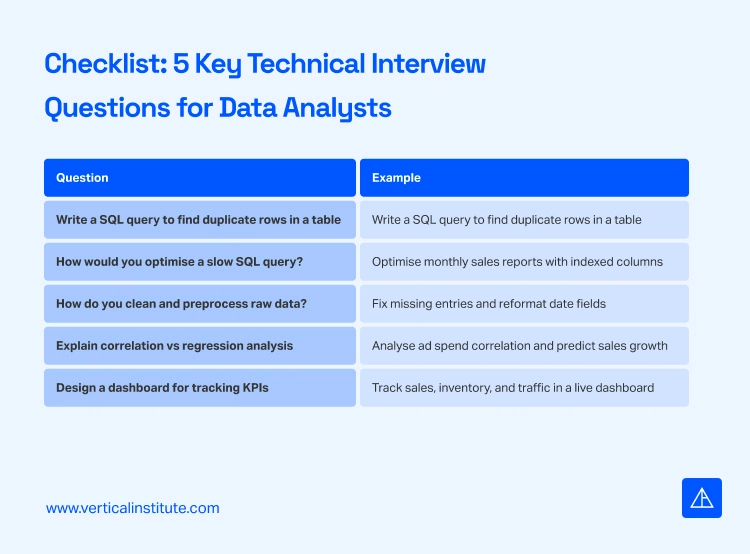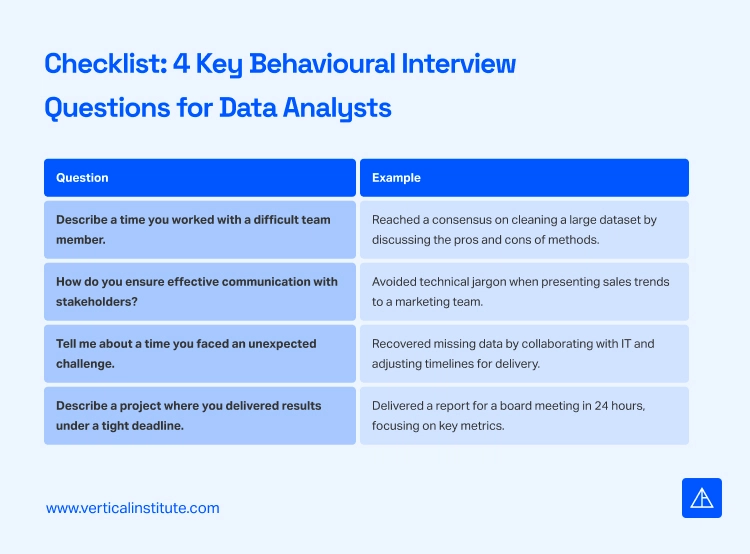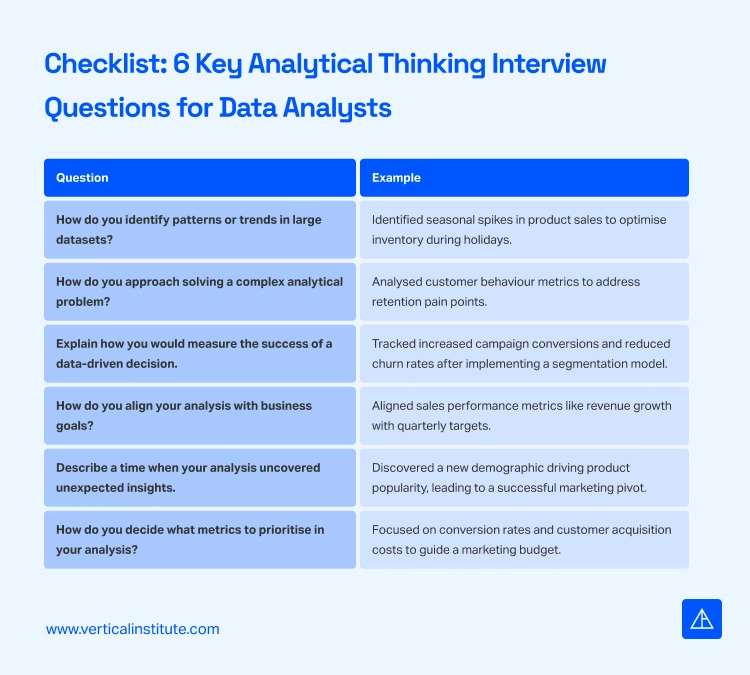Preparing for a data analyst job interview requires a thorough understanding of the role’s technical and behavioural aspects. Whether you’re an aspiring data analyst or a seasoned professional looking to switch roles, practising common interview questions can make a significant difference.
In this article, we’ll break down 15 essential data analyst job interview questions into technical, analytical, and behavioural categories, helping you craft responses that effectively showcase your skills.
Related: How to Ace Your Video Job Interview in Singapore?
What to Expect in a Data Analyst Job Interview
Data analyst interviews often combine technical problem-solving, business acumen, and interpersonal skills. Candidates are evaluated on their ability to work with data and derive actionable insights that benefit the organisation.
Overview of the Role
Data analysts transform raw data into meaningful insights. This involves data cleaning, analysis, and visualisation, often requiring expertise in SQL, statistical tools, and dashboards like Tableau or Power BI.
Related: Power BI vs Tableau: What is the Best Data Visualisation Tool to Learn
Key Topics in Interviews
Interview questions may focus on technical proficiency (e.g., SQL queries or data modelling), problem-solving skills (e.g., handling missing data), and communication (e.g., presenting findings to stakeholders).
Practising a mix of technical and behavioural questions ensures you’re prepared for diverse scenarios.
15 Data Analyst Job Interview Questions to Prepare For
Here are 15 key questions to help you stand out and demonstrate your expertise effectively.
Technical Questions
Technical questions test your core data analysis skills and familiarity with tools like SQL, Excel, and data visualisation software. Mastering these questions will help demonstrate your ability to handle real-world scenarios effectively.
1. Can you write an SQL query to find duplicate rows in a table?
Duplicate data can skew results and lead to inaccurate conclusions. Identifying and managing duplicates shows you understand data quality and database maintenance.
Example: Suppose you are working with customer data and must identify duplicate entries based on email addresses to ensure accurate marketing segmentation.
2. How would you optimise a slow SQL query?
This question assesses your efficiency in handling large datasets. Techniques such as indexing, restructuring queries, or avoiding unnecessary operations illustrate your ability to improve performance.
Example: Imagine working on a retail sales database where monthly reports take too long to generate. You optimise the query by indexing the sales_date column and restructuring subqueries.
3. How do you clean and preprocess raw data for analysis?
Data cleaning ensures accuracy and reliability. Explaining methods such as handling missing values, removing duplicates, or standardising formats showcases your attention to detail.
Example: You preprocess sales data by handling missing entries for certain months and reformat inconsistent date fields to ensure proper trend analysis.
4. Explain the difference between correlation and regression analysis.
This question tests your grasp of foundational statistical techniques. Correlation measures relationships, while regression predicts outcomes, making these tools essential for informed decision-making.
Example: While analysing customer data, you use correlation to find a relationship between ad spend and sales and regression to predict future sales based on budget increases.
5. Describe how you would design a dashboard for tracking business KPIs.
Creating a meaningful dashboard involves balancing clarity, accessibility, and relevance. Highlighting your approach to selecting metrics and organising visualisations shows business awareness.
Example: For an e-commerce business, you design a dashboard that tracks metrics like daily sales, inventory levels, and website traffic, updating in real-time for quick decision-making.

Related: How SQL Can Help With Your Future Data Analytics Career
Behavioural Question
Behavioural questions test how well you handle real-world situations, work with teams, and approach challenges in your professional life. Structuring your answers with the STAR method (Situation, Task, Action, Result) can help you provide clear, concise responses.
6. Describe a time you worked with a difficult team member. How did you handle it?
Conflict resolution and teamwork are essential skills for data analysts who often collaborate with cross-functional teams. Highlight how you navigated the situation and maintained project goals.
Example: You worked with a team member who disagreed on cleaning a large dataset. By openly discussing the pros and cons of each method, you reached a consensus that improved the project’s outcomes.
7. How do you ensure effective communication with stakeholders from different departments?
Data analysts often work with technical and non-technical teams. This question evaluates your ability to adapt your communication style to meet the needs of various stakeholders.
Example: While presenting a sales analysis to the marketing team, you avoided technical jargon and focused on how the trends aligned with their campaign goals.
8. Tell me about a time you faced an unexpected challenge in a data analysis project. What did you do?
Unexpected challenges are common in data analysis. This question assesses your ability to stay resourceful and solution-oriented under pressure.
Example: During a project, you discovered missing data in critical columns. You quickly rechecked data sources, collaborated with IT to retrieve backups, and adjusted timelines to deliver accurate results.
9. Describe a project where you delivered results under a tight deadline.
This question evaluates your ability to work efficiently without compromising quality.
Example: You were tasked with preparing a data-driven report for a board meeting in 24 hours. You met the deadline and provided accurate insights by focusing on key metrics and automating data-cleaning steps.

Analytical Thinking
Analytical thinking questions focus on how you interpret data, identify trends, and connect insights to business objectives. These questions demonstrate your ability to think critically and add value.
10. How do you identify patterns or trends in large datasets?
Spotting trends requires technical skill and business insight. To detect correlations or seasonal patterns, highlight methods such as using statistical software or creating visualisations.
Example: You analysed a large product sales dataset and identified seasonal spikes during holidays, helping your team optimise inventory.
Related: Top Platforms for Data Analytics and Data Science Datasets
11. How do you approach solving a complex analytical problem?
This will test your problem-solving framework. Break down the problem into smaller steps, understanding the data, and iterating solutions.
Example: When customer retention rates are low, you analyse customer behaviour metrics to identify and address pain points in the user journey.
12. Explain how you would measure the success of a data-driven decision.
Measuring success requires defining KPIs, tracking performance, and gathering feedback. Highlight how you align metrics with business objectives and continuously evaluate impact.
Example: After developing a customer segmentation model, you measured its success by tracking increased campaign conversions and reduced churn rates.
13. How do you align your analysis with business goals?
This question tests how you connect data work with organisational objectives. Discuss working with stakeholders to ensure alignment with goals.
Example: While creating a sales performance report, you aligned revenue growth and market expansion metrics with quarterly targets.
14. Describe a time when your analysis uncovered unexpected insights.
This question highlights your ability to discover hidden opportunities or risks through data analysis.
Example: You uncovered a previously unnoticed trend where a product’s popularity increased among a new customer demographic, leading to a successful marketing pivot.
15. How do you decide what metrics to prioritise in your analysis?
This question evaluates your ability to focus on what matters most for driving results.
Example: While working on a marketing campaign report, you prioritised conversion rates and customer acquisition costs to guide budget adjustments.

Related: 7 Data Visualisation and Analytics Trends for Smarter Decisions in 2025
Tips for Crafting the Best Answers
Providing clear, structured answers to data analyst job interview questions is key to showcasing your expertise and thought process. Here are two strategies to craft compelling responses.
Structuring Responses with the STAR Technique
The STAR technique helps you organise answers by breaking them into four parts:
- Situation: Describe the context or background of the scenario.
- Task: Explain the specific challenge or responsibility you faced.
- Action: Detail the steps you took to address the challenge.
- Result: Share the outcome and its impact.
Using STAR ensures your answers are clear and concise and demonstrates problem-solving effectively.
Backing Answers with Real-world Examples
Use concrete examples from past projects to illustrate your skills and problem-solving abilities whenever possible. Tailor these examples to match the specific question being asked. By grounding answers in real-world experiences, you demonstrate practical expertise and relevance to the role. Ensure your examples align with the company’s industry and goals.
Conclusion
A data analyst job interview is your chance to demonstrate the value you can bring through your analytical skills and problem-solving mindset. With preparation and confidence, you can position yourself as a key contributor to any organisation, driving decisions that matter and advancing toward a fulfilling career in data analytics.
Ace Your Data Analyst Interview and Calculate Your Future Salary
Get ready to tackle essential data analyst job interview questions and take the next step in your career. Use our Salary Calculator to discover how much you could earn in this exciting field.
SALARY CALCULATOR
Discover how much you can earn in your dream role.
About Vertical Institute
Vertical Institute is revolutionising the future of work by empowering individuals with essential skills to excel in today’s evolving job market. Our comprehensive courses and certifications are designed to cultivate vital skills and nurture the next generation of visionaries and trailblazers.
As a certified Approved Training Provider (ATO) recognised by SkillsFuture Singapore (SSG) and the Institute of Banking & Finance Singapore (IBF), Vertical Institute offers state-of-the-art, government-subsidised tech courses. Participants in our programs are eligible for SkillsFuture Credits and NTUC UTAP funding, which helps alleviate education costs.



